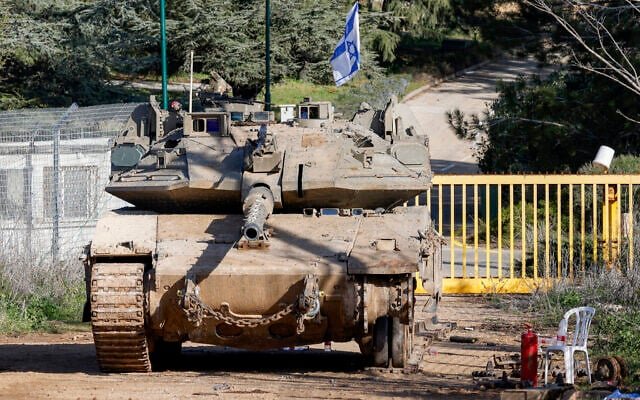The Israel Defense Forces on Wednesday carried out a strike in southern Lebanon, killing a Hezbollah operative.
He was the first person killed by the IDF in Lebanon since Israel withdrew from most of the border area a day earlier.
The official National News agency reported the “enemy drone struck a vehicle… in the town of Ayta ash-Shab,” near the southern border.
An IDF statement said the Hezbollah member was targeted in the town after he was seen handling weapons.
The NNA had earlier said one person was wounded in the Wazzani region, elsewhere along the frontier, after Israeli forces opened fire “while residents were inspecting” restaurants and cafes in the area.
The NNA also reported Israeli automatic weapons fire toward homes near the town of Shebaa.
In a separate incident on Wednesday, the IDF said it fired warning shots in the Kafr Kila area in southern Lebanon after a group of suspects gathered close to the Israeli border. The suspects withdrew after the shots were fired, the military added.
A November 27 ceasefire deal had halted more than a year of hostilities between Israel and Hezbollah, including two months of all-out war, that was started by the Iran-backed terror group, some of whose supporters on Wednesday hoisted Hezbollah flags in several Lebanese villages near the border following the IDF pullout.
David Azoulay, mayor of the border town of Metula, lambasted the Israeli government, telling Channel 12 news, “The government of abandonment is continuing on its path in the north. Dozens of Hezbollah men [arrived] under the guise of civilians — and there is zero response. Once again we are containing and containing it.”
Under the terms of the deal, brokered by the United States, Israeli troops were granted 60 days to withdraw from southern Lebanon, where they had waged a ground offensive against fighters from Lebanon’s Hezbollah terror group since early October.
Hezbollah operatives were to leave the zone and Lebanese troops were to deploy in the area within the same period. The original withdrawal deadline was January 26, but was extended until February 18 as Israel argued the Lebanese army was not deploying quickly enough. In the meantime, the IDF uncovered weapons caches along the border and carried out strikes on Hezbollah targets it said posed a threat.
Israel announced just before the February deadline that it would temporarily keep troops in “five strategic points” near the border.
The army said they were hilltops overlooking the frontier where troops would remain to “make sure there’s no immediate threat.”
Lebanese leaders said Tuesday they were in contact with ceasefire brokers the United States and France to press Israel to fully withdraw, branding its continued presence in five places an “occupation.”
The UN called the incomplete pullout a violation of a Security Council resolution.
The IDF did not officially confirm completing the pullout, but the matter was confirmed by observers on both sides. Defense Minister Israel Katz said the IDF was remaining in “a buffer zone,” with “five strategic outposts,” and would enforce the ceasefire “against any violation by Hezbollah.”
Prime Minister Benjamin Netanyahu had warned in November that Israel would maintain “full military freedom of action” in case of any truce breach.
Last week, the US authorized the IDF to remain in the five points, though it was not clear how long troops would stay there.
The conflict began on October 8, 2023, when Hezbollah began firing across the border, one day after Palestinian terror group Hamas led an invasion of southern Israel that killed 1,200 people, mostly civilians, and triggered war in the Gaza Strip.
Hezbollah rocket and drone fire forced the evacuation of 60,000 residents from northern Israel and caused major damage in many towns and communities.
As Hezbollah’s rocket fire reached further into Israel fighting escalated into open war in September, during which the terror group suffered significant losses to its leadership and weapons stockpiles.
A complex, three-phase ceasefire between Israel and Hamas began in January, though only the first stage has begun so far and talks have yet to start on the latter stages.
